Table of Contents
- Alienware 15 R4 Service Manual
- Before working inside your computer
- After working inside your computer
- Removing the base cover
- Replacing the base cover
- Removing the wireless card
- Replacing the wireless card
- Removing the hard drive
- Replacing the hard drive
- Removing the solid-state drive
- Replacing the solid-state drive
- Removing the memory modules
- Replacing the memory modules
- Removing the rear-I/O cover
- Replacing the rear-I/O cover
- Removing the computer base
- Replacing the computer base
- Removing the coin-cell battery
- Replacing the coin-cell battery
- Removing the battery
- Replacing the battery
- Removing the touchpad
- Replacing the touchpad
- Removing the I/O board
- Replacing the I/O board
- Removing the speakers
- Replacing the speakers
- Removing the system board
- Replacing the system board
- Removing the keyboard
- Replacing the keyboard
- Removing the macro keys
- Replacing the macro keys
- Removing the heat-sink assembly
- Replacing the heat-sink assembly
- Removing the power-adapter port
- Replacing the power-adapter port
- Removing the power-button board
- Replacing the power-button board
- Removing the palm rest
- Replacing the palm rest
- Removing the display assembly
- Replacing the display assembly
- Downloading drivers
- System setup
- Troubleshooting
- Getting help and contacting Alienware
Alienware 15 R4 User Manual
Displayed below is the user manual for 15 R4 by Alienware which is a product in the Notebooks category. This manual has pages.
Related Manuals

Alienware 15 R4
Service Manual
Computer Model: Alienware 15 R4
Regulatory Model: P69F
Regulatory Type: P69F002

Notes, cautions, and warnings
NOTE: A NOTE indicates important information that helps you make
better use of your product.
CAUTION: A CAUTION indicates either potential damage to
hardware or loss of data and tells you how to avoid the problem.
WARNING: A WARNING indicates a potential for property damage,
personal injury, or death.
© 2018 Dell Inc. or its subsidiaries. All rights reserved. Dell, EMC, and other
trademarks are trademarks of Dell Inc. or its subsidiaries. Other trademarks may be
trademarks of their respective owners.
2018 - 03
Rev. A00

Contents
Before working inside your computer........................ 10
Before you begin ........................................................................... 10
Safety instructions...........................................................................10
Recommended tools........................................................................ 11
Screw list........................................................................................ 12
After working inside your computer...........................14
Removing the base cover.............................................15
Procedure.......................................................................................15
Replacing the base cover.............................................18
Procedure.......................................................................................18
Removing the wireless card.........................................21
Prerequisites................................................................................... 21
Procedure...................................................................................... 22
Replacing the wireless card.........................................24
Procedure......................................................................................24
Post-requisites................................................................................25
Removing the hard drive.............................................26
Prerequisites.................................................................................. 26
Procedure......................................................................................26
3

Replacing the hard drive.............................................29
Procedure......................................................................................29
Post-requisites................................................................................ 31
Removing the solid-state drive................................... 32
Prerequisites...................................................................................32
Procedure...................................................................................... 32
Replacing the solid-state drive................................... 34
Procedure...................................................................................... 34
Post-requisites................................................................................35
Removing the memory modules..................................36
Prerequisites...................................................................................36
Procedure...................................................................................... 36
Replacing the memory modules..................................38
Procedure...................................................................................... 38
Post-requisites................................................................................39
Removing the rear-I/O cover.....................................40
Prerequisites.................................................................................. 40
Procedure......................................................................................40
Replacing the rear-I/O cover..................................... 42
Procedure......................................................................................42
Post-requisites................................................................................43
Removing the computer base......................................44
Prerequisites.................................................................................. 44
Procedure......................................................................................44
4

Replacing the computer base......................................48
Procedure......................................................................................48
Post-requisites............................................................................... 50
Removing the coin-cell battery................................... 51
Prerequisites...................................................................................51
Procedure.......................................................................................51
Replacing the coin-cell battery...................................53
Procedure...................................................................................... 53
Post-requisites................................................................................54
Removing the battery..................................................55
Prerequisites.................................................................................. 55
Procedure......................................................................................55
Replacing the battery..................................................57
Procedure...................................................................................... 57
Post-requisites................................................................................58
Removing the touchpad.............................................. 59
Prerequisites.................................................................................. 59
Procedure......................................................................................59
Replacing the touchpad...............................................62
Procedure......................................................................................62
Post-requisites................................................................................63
Removing the I/O board.............................................64
Prerequisites.................................................................................. 64
Procedure......................................................................................64
5

Replacing the I/O board.............................................66
Procedure......................................................................................66
Post-requisites................................................................................67
Removing the speakers............................................... 68
Prerequisites.................................................................................. 68
Procedure......................................................................................68
Replacing the speakers............................................... 70
Procedure......................................................................................70
Post-requisites.................................................................................71
Removing the system board........................................72
Prerequisites...................................................................................72
Procedure...................................................................................... 72
Replacing the system board........................................78
Procedure...................................................................................... 78
Post-requisites................................................................................82
Removing the keyboard.............................................. 83
Prerequisites...................................................................................83
Procedure...................................................................................... 83
Replacing the keyboard.............................................. 86
Procedure......................................................................................86
Post-requisites................................................................................87
Removing the macro keys........................................... 88
Prerequisites...................................................................................88
Procedure......................................................................................89
6

Replacing the macro keys........................................... 90
Procedure......................................................................................90
Post-requisites................................................................................ 91
Removing the heat-sink assembly.............................. 92
Prerequisites.................................................................................. 92
Procedure......................................................................................92
Replacing the heat-sink assembly.............................. 95
Procedure......................................................................................95
Post-requisites................................................................................97
Removing the power-adapter port.............................98
Prerequisites.................................................................................. 98
Procedure......................................................................................98
Replacing the power-adapter port...........................100
Procedure....................................................................................100
Post-requisites.............................................................................. 101
Removing the power-button board.......................... 102
Prerequisites.................................................................................102
Procedure.................................................................................... 102
Replacing the power-button board.......................... 104
Procedure.................................................................................... 104
Post-requisites..............................................................................105
Removing the palm rest.............................................106
Prerequisites.................................................................................106
Procedure.................................................................................... 107
7

Replacing the palm rest.............................................108
Procedure.................................................................................... 108
Post-requisites..............................................................................108
Removing the display assembly................................109
Prerequisites.................................................................................109
Procedure.....................................................................................110
Replacing the display assembly.................................113
Procedure..................................................................................... 113
Post-requisites...............................................................................115
Downloading drivers................................................. 116
Operating system.......................................................................... 116
Downloading the audio driver....................................................... 116
Downloading the graphics driver................................................... 116
Downloading the USB driver..........................................................117
Downloading the Wi-Fi driver....................................................... 118
Downloading the media-card reader driver....................................119
Downloading the chipset driver.................................................... 120
Downloading the network driver...................................................120
System setup..............................................................122
Boot Sequence.............................................................................122
Navigation keys............................................................................ 122
BIOS overview..............................................................................123
Entering BIOS setup program........................................................123
Enabling or disabling the USB in BIOS setup program.............. 124
Identifying the hard drive in BIOS setup program..................... 124
Checking the system memory in BIOS setup program................124
System setup options.....................................................................125
8

Troubleshooting......................................................... 133
Flashing the BIOS......................................................................... 133
Flashing BIOS (USB key)............................................................... 133
Reinstall Windows using a USB recovery drive............................... 134
Enhanced Pre-Boot System Assessment (ePSA) diagnostics............ 135
Running the ePSA diagnostics..................................................135
Diagnostics...................................................................................136
Wi-Fi power cycle.........................................................................137
Flea power release........................................................................ 138
Getting help and contacting Alienware................... 139
Self-help resources....................................................................... 139
Contacting Alienware................................................................... 139
9

Before working inside your
computer
NOTE: The images in this document may dier from your computer
depending on the conguration you ordered.
Before you begin
1 Save and close all open les and exit all open applications.
2 Shut down your computer. Click Start → Power → Shut down.
NOTE: If you are using a dierent operating system, see the
documentation of your operating system for shut-down instructions.
3 Disconnect your computer and all attached devices from their electrical
outlets.
4 Disconnect all attached network devices and peripherals, such as keyboard,
mouse, and monitor from your computer.
5 Remove any media card and optical disc from your computer, if applicable.
Safety instructions
Use the following safety guidelines to protect your computer from potential
damage and ensure your personal safety.
WARNING: Before working inside your computer, read the safety
information that shipped with your computer. For more safety best
practices, see the Regulatory Compliance home page at www.dell.com/
regulatory_compliance.
WARNING: Disconnect all power sources before opening the computer
cover or panels. After you nish working inside the computer, replace all
covers, panels, and screws before connecting to the electrical outlet.
CAUTION: To avoid damaging the computer, ensure that the work
surface is at and clean.
10

CAUTION: To avoid damaging the components and cards, handle them by
their edges, and avoid touching pins and contacts.
CAUTION: You should only perform troubleshooting and repairs as
authorized or directed by the Dell technical assistance team. Damage due
to servicing that is not authorized by Dell is not covered by your
warranty. See the safety instructions that shipped with the product or at
www.dell.com/regulatory_compliance.
CAUTION: Before touching anything inside your computer, ground
yourself by touching an unpainted metal surface, such as the metal at the
back of the computer. While you work, periodically touch an unpainted
metal surface to dissipate static electricity, which could harm internal
components.
CAUTION: When you disconnect a cable, pull on its connector or on its
pull tab, not on the cable itself. Some cables have connectors with locking
tabs or thumb-screws that you must disengage before disconnecting the
cable. When disconnecting cables, keep them evenly aligned to avoid
bending any connector pins. When connecting cables, ensure that the
ports and connectors are correctly oriented and aligned.
CAUTION: Press and eject any installed card from the media-card reader.
Recommended tools
The procedures in this document may require the following tools:
• Phillips screwdriver #1
• Plastic scribe
11

Screw list
Table 1. Screw list
Component Secured to Screw type Quantity Screw image
Base cover Palm-rest
assembly
M2.5x13 6
Battery Palm-rest
assembly
M2.5x5 1
Solid-state
drive
Computer base M2x3 1
Hard-drive
assembly
Computer base M2.5x8 3
Hard-drive
bracket
Hard-drive
assembly
M3x3 4
Heat-sink
assembly
System board M2x3 7
Rear-I/O cover Palm-rest
assembly
M2.5x7 2
Computer base Palm-rest
assembly
M2.5x8 11
Tron-light
holder
Palm-rest
assembly
M2.5x5 2
Display hinges Display back-
cover
M2.5x3 14
12

Component Secured to Screw type Quantity Screw image
I/O board Palm-rest
assembly
M2.5x5 2
Touch-pad
bracket
Palm-rest
assembly
M2x3 5
Display
assembly
Palm-rest
assembly
M2.5x5 6
Display panel Display back-
cover
M2x3 4
Power-adapter
port bracket
Palm-rest
assembly
M2x3 1
Power-button
board
Palm-rest
assembly
M2x3 2
System-board
assembly
Palm-rest
assembly
M2.5x5 7
Keyboard
bracket
Palm-rest
assembly
M2x3 15
Wireless-card
bracket
Computer base M2x3 1
13

After working inside your
computer
CAUTION: Leaving stray or loose screws inside your computer may
severely damage your computer.
1 Replace all screws and ensure that no stray screws remain inside your
computer.
2 Connect any external devices, peripherals, or cables you removed before
working on your computer.
3 Replace any media cards, discs, or any other parts that you removed before
working on your computer.
4 Connect your computer and all attached devices to their electrical outlets.
5 Turn on your computer.
14

Removing the base cover
WARNING: Before working inside your computer, read the safety
information that shipped with your computer and follow the steps in
Before working inside your computer. After working inside your
computer, follow the instructions in After working inside your computer.
For more safety best practices, see the Regulatory Compliance home
page at www.dell.com/regulatory_compliance.
Procedure
1 Remove the six screws (M2.5x13) that secure the base cover to the computer
base.
2 Loosen the captive screw that secures the base cover to the computer base to
open a gap between the two parts.
15

3 Using a plastic scribe, gently pry the base cover from the gap around the
captive screw to release the clips on the base cover from the computer base.
4 Lift the base cover o the computer base.
16

5 Disconnect the battery cable from the system board.
6 Press and hold the power button for ve seconds to ground the system board.
17
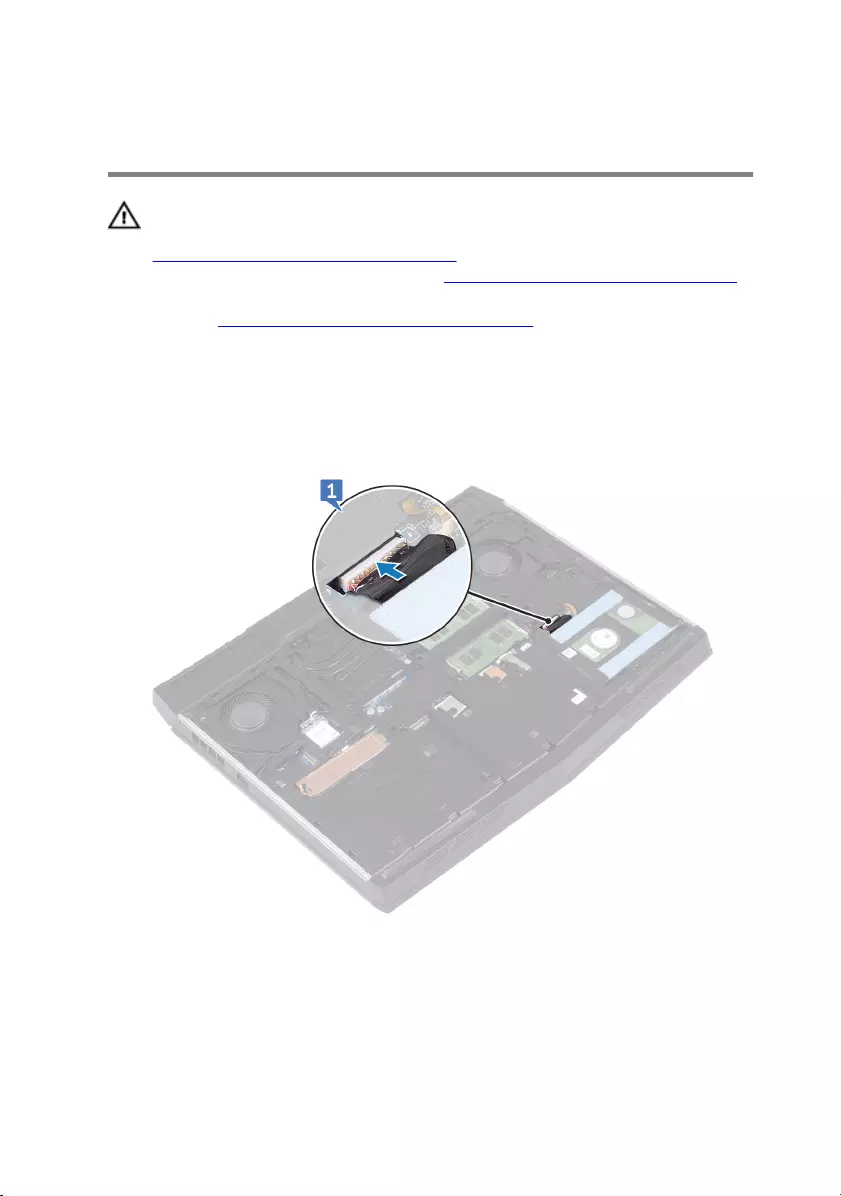
Replacing the base cover
WARNING: Before working inside your computer, read the safety
information that shipped with your computer and follow the steps in
Before working inside your computer. After working inside your
computer, follow the instructions in After working inside your computer.
For more safety best practices, see the Regulatory Compliance home
page at www.dell.com/regulatory_compliance.
Procedure
1 Connect the battery cable to the system board.
2 Slide the base cover into the slots on the computer base.
18

3 Snap the base cover into place.
4 Tighten the captive screw that secures the base cover to the computer base.
19

5 Replace the six screws (M2.5x13) that secure the base cover to the computer
base.
20

Removing the wireless card
WARNING: Before working inside your computer, read the safety
information that shipped with your computer and follow the steps in
Before working inside your computer. After working inside your
computer, follow the instructions in After working inside your computer.
For more safety best practices, see the Regulatory Compliance home
page at www.dell.com/regulatory_compliance.
Prerequisites
Remove the base cover.
21

Procedure
1 Lift the ap covering the wireless card to access the wireless-card bracket
and screw.
2 Remove the screw (M2x3) that secures the wireless-card bracket to the
computer base.
NOTE: To avoid potential damage to the wireless-card bracket,
carefully lift it at an angle and remove it from the wireless card.
3 Lift the wireless-card bracket o the wireless card.
4 Lift the wireless card at an angle, and slide it out of the wireless-card slot.
22

5 Disconnect the antenna cables from the wireless card.
23

Replacing the wireless card
WARNING: Before working inside your computer, read the safety
information that shipped with your computer and follow the steps in
Before working inside your computer. After working inside your
computer, follow the instructions in After working inside your computer.
For more safety best practices, see the Regulatory Compliance home
page at www.dell.com/regulatory_compliance.
Procedure
CAUTION: To avoid damaging the wireless card, do not place any cables
under it.
1 Connect the antenna cables to the wireless card.
The following table provides the antenna-cable color scheme for the wireless
card supported by your computer.
Table 2. Antenna-cable color scheme
Connectors on the wireless card Antenna cable color
Auxiliary (black triangle) Black
Main (white triangle) White
2 Slide the wireless card bracket on to the wireless card, and align the screw
hole on the wireless-card bracket with the screw hole on the wireless card.
3 Align the notch on the wireless card with the tab on the wireless-card slot,
and then slide the wireless card at an angle into the wireless-card slot.
24

Removing the hard drive
WARNING: Before working inside your computer, read the safety
information that shipped with your computer and follow the steps in
Before working inside your computer. After working inside your
computer, follow the instructions in After working inside your computer.
For more safety best practices, see the Regulatory Compliance home
page at www.dell.com/regulatory_compliance.
CAUTION: Hard drives are fragile. Exercise care when handling the hard
drive.
CAUTION: To avoid data loss, do not remove the hard drive while the
computer is in sleep or on state.
Prerequisites
Remove the base cover.
Procedure
1 Using the pull-tab, disconnect the hard-drive cable from the system board.
2 Remove the three screws (M2.5x8) that secure the hard-drive assembly to the
computer base.
26

3 Lift the hard-drive assembly along with its cable o the computer base.
4 Remove the four screws (M3x3) that secure the hard-drive bracket to the
hard-drive assembly.
5 Lift the hard-drive bracket o the hard-drive assembly.
27

6 Disconnect the interposer from the hard drive.
28

Replacing the hard drive
WARNING: Before working inside your computer, read the safety
information that shipped with your computer and follow the steps in
Before working inside your computer. After working inside your
computer, follow the instructions in After working inside your computer.
For more safety best practices, see the Regulatory Compliance home
page at www.dell.com/regulatory_compliance.
CAUTION: Hard drives are fragile. Exercise care when handling the hard
drive.
Procedure
1 Connect the interposer to the hard drive.
2 Align the screw holes on the hard-drive bracket with the screw holes on the
hard-drive assembly.
29

3 Replace the four screws (M3x3) that secure the hard-drive bracket to the
hard-drive assembly.
4 Align the screw holes on the hard-drive assembly with the screw holes on the
computer base.
5 Replace the three screws (M2.5x8) that secure the hard-drive assembly to the
computer base.
30

Removing the solid-state drive
WARNING: Before working inside your computer, read the safety
information that shipped with your computer and follow the steps in
Before working inside your computer. After working inside your
computer, follow the instructions in After working inside your computer.
For more safety best practices, see the Regulatory Compliance home
page at www.dell.com/regulatory_compliance.
CAUTION: Solid-state drives are fragile. Exercise care when handling the
solid-state drive.
CAUTION: To avoid data loss, do not remove the solid-state drive while
the computer is in sleep or on state.
Prerequisites
Remove the base cover.
Procedure
1 Remove the screw (M2x3) that secures the solid-state drive shield and solid-
state drive to the computer base.
2 Peel o the solid-state drive shield from the solid-state drive.
NOTE: Solid-state drive shield is applicable to computers that are
shipped with 1 TB solid-state drive.
32

3 Slide and remove the solid-state drive from the solid-state drive slot.
33

Replacing the solid-state drive
WARNING: Before working inside your computer, read the safety
information that shipped with your computer and follow the steps in
Before working inside your computer. After working inside your
computer, follow the instructions in After working inside your computer.
For more safety best practices, see the Regulatory Compliance home
page at www.dell.com/regulatory_compliance.
CAUTION: Solid-state drives are fragile. Exercise care when handling the
solid-state drive.
Procedure
1 Align the notch on the solid-state drive with the tab on the solid-state drive
slot.
2 Slide the solid-state drive into the solid-state drive slot.
3 Slide and adhere the solid-state drive shield on the solid-state drive.
34

Removing the memory modules
WARNING: Before working inside your computer, read the safety
information that shipped with your computer and follow the steps in
Before working inside your computer. After working inside your
computer, follow the instructions in After working inside your computer.
For more safety best practices, see the Regulatory Compliance home
page at www.dell.com/regulatory_compliance.
Prerequisites
Remove the base cover.
Procedure
1 Using your ngertips, carefully spread apart the securing clips on each end of
the memory-module slot until the memory module pops up.
36

2 Slide and remove the memory module from the memory-module slot.
37

Replacing the memory modules
WARNING: Before working inside your computer, read the safety
information that shipped with your computer and follow the steps in
Before working inside your computer. After working inside your
computer, follow the instructions in After working inside your computer.
For more safety best practices, see the Regulatory Compliance home
page at www.dell.com/regulatory_compliance.
Procedure
1 Align the notch on the memory module with the tab on the memory-module
slot and slide the memory module rmly into the slot at an angle.
38

Removing the rear-I/O cover
WARNING: Before working inside your computer, read the safety
information that shipped with your computer and follow the steps in
Before working inside your computer. After working inside your
computer, follow the instructions in After working inside your computer.
For more safety best practices, see the Regulatory Compliance home
page at www.dell.com/regulatory_compliance.
Prerequisites
Remove the base cover.
Procedure
1 Remove the two screws (M2.5x7) that secure the rear-I/O cover to the palm-
rest assembly.
2 Using a plastic scribe, disengage the rear-I/O cover from the computer base
on the proper pry locations.
40

3 Pull the rear-I/O cover from the computer base.
41

Replacing the rear-I/O cover
WARNING: Before working inside your computer, read the safety
information that shipped with your computer and follow the steps in
Before working inside your computer. After working inside your
computer, follow the instructions in After working inside your computer.
For more safety best practices, see the Regulatory Compliance home
page at www.dell.com/regulatory_compliance.
Procedure
1 Align the tabs on the rear-I/O cover with the slots on the computer base and
snap the rear-I/O cover into place.
42

Removing the computer base
WARNING: Before working inside your computer, read the safety
information that shipped with your computer and follow the steps in
Before working inside your computer. After working inside your
computer, follow the instructions in After working inside your computer.
For more safety best practices, see the Regulatory Compliance home
page at www.dell.com/regulatory_compliance.
Prerequisites
1 Remove the base cover.
2 Follow the procedure from step 1 to step 3 in "Removing the hard drive".
3 Remove the solid-state drive.
4 Remove the wireless card.
5 Remove the rear-I/O cover.
Procedure
1 Note the antenna cables routing and remove the antenna cables from the
routing guides on the computer base.
44

2 Disconnect the left and right tron-light cables from the system board.
3 Remove the two screws (M2x3) that secure the tron-light holder to the palm-
rest assembly.
45

4 Remove the 11 screws (M2.5x8) that secure the computer base to the palm-
rest assembly.
5 Starting from left corner, pry the computer base o the palm-rest assembly to
release the tabs from the slots on the palm-rest assembly.
46

6 Lift the computer base o the palm-rest assembly.
47

Replacing the computer base
WARNING: Before working inside your computer, read the safety
information that shipped with your computer and follow the steps in
Before working inside your computer. After working inside your
computer, follow the instructions in After working inside your computer.
For more safety best practices, see the Regulatory Compliance home
page at www.dell.com/regulatory_compliance.
Procedure
1 Align and snap the computer base on the palm-rest assembly.
2 Replace the 11 screws (M2.5x8) that secure the computer base to the palm-
rest assembly.
48

3 Replace the two screws (M2x3) that secure the tron-light holder to the palm-
rest assembly.
4 Connect the left and right tron-light cables to the system board.
49

Removing the coin-cell battery
WARNING: Before working inside your computer, read the safety
information that shipped with your computer and follow the steps in
Before working inside your computer. After working inside your
computer, follow the instructions in After working inside your computer.
For more safety best practices, see the Regulatory Compliance home
page at www.dell.com/regulatory_compliance.
CAUTION: Removing the coin-cell battery resets the BIOS setup
program’s settings to default. It is recommended that you note the BIOS
setup program’s settings before removing the coin-cell battery.
Prerequisites
1 Remove the base cover.
2 Remove the wireless card.
3 Follow the procedure from step 1 to step 3 in "Removing the hard drive".
4 Remove the solid-state drive.
5 Remove the rear-I/O cover.
6 Remove the computer base.
Procedure
1 Peel the tape to access the coin-cell battery cable on the system board.
2 Disconnect the coin-cell battery cable from the system board.
3 Note the cable routing and remove the coin-cell battery cable from the
routing guide on the palm-rest assembly.
51

4 Gently peel o the coin-cell battery along with its cable o the palm-rest
assembly.
52

Replacing the coin-cell battery
WARNING: Before working inside your computer, read the safety
information that shipped with your computer and follow the steps in
Before working inside your computer. After working inside your
computer, follow the instructions in After working inside your computer.
For more safety best practices, see the Regulatory Compliance home
page at www.dell.com/regulatory_compliance.
Procedure
1 Adhere the coin-cell battery to the palm-rest assembly.
2 Connect the coin-cell battery cable to the system board.
3 Route the coin-cell battery cable through the routing guide and adhere the
tape that secures the coin-cell battery cable to the system board.
53

Removing the battery
WARNING: Before working inside your computer, read the safety
information that shipped with your computer and follow the steps in
Before working inside your computer. After working inside your
computer, follow the instructions in After working inside your computer.
For more safety best practices, see the Regulatory Compliance home
page at www.dell.com/regulatory_compliance.
Prerequisites
1 Remove the base cover.
2 Remove the wireless card.
3 Follow the procedure from step 1 to step 3 in "Removing the hard drive".
4 Remove the solid-state drive.
5 Remove the rear-I/O cover.
6 Remove the computer base.
Procedure
1 Remove the screw (M2.5x5) that secures the battery to the palm-rest
assembly.
55

2 Lift the battery, along with its cable, o the palm-rest assembly.
56

Replacing the battery
WARNING: Before working inside your computer, read the safety
information that shipped with your computer and follow the steps in
Before working inside your computer. After working inside your
computer, follow the instructions in After working inside your computer.
For more safety best practices, see the Regulatory Compliance home
page at www.dell.com/regulatory_compliance.
Procedure
1 Align the screw hole on the battery with the screw hole on the palm-rest
assembly.
2 Replace the screw (M2.5x5) that secures the battery to the palm-rest
assembly.
57

Removing the touchpad
WARNING: Before working inside your computer, read the safety
information that shipped with your computer and follow the steps in
Before working inside your computer. After working inside your
computer, follow the instructions in After working inside your computer.
For more safety best practices, see the Regulatory Compliance home
page at www.dell.com/regulatory_compliance.
Prerequisites
1 Remove the base cover.
2 Remove the wireless card.
3 Follow the procedure from step 1 to step 3 in "Removing the hard drive".
4 Remove the solid-state drive.
5 Remove the rear-I/O cover.
6 Remove the computer base.
7 Remove the battery.
Procedure
1 Open the latch and disconnect the touchpad cable from the system board.
2 Open the latches and disconnect the other end of the touchpad cable and
the touchpad-buttons cable from the touchpad.
3 Remove the ve screws (M2x3) that secure the touchpad bracket to the
palm-rest assembly.
59

4 Lift the touchpad bracket o the palm-rest assembly.
5 Open the computer 90 degrees, and using a plastic scribe to release the
touchpad from the adhesive on the palm-rest assembly.
60

6 Peel the touchpad o the palm-rest assembly.
CAUTION: To avoid potential damage to the alignment posts on
palm-rest assembly, carefully peel the touchpad o the palm-rest
assembly.
61

Replacing the touchpad
WARNING: Before working inside your computer, read the safety
information that shipped with your computer and follow the steps in
Before working inside your computer. After working inside your
computer, follow the instructions in After working inside your computer.
For more safety best practices, see the Regulatory Compliance home
page at www.dell.com/regulatory_compliance.
Procedure
1 Using the alignment posts on the palm-rest assembly, place the touchpad to
the palm-rest assembly.
NOTE: Clean the adhesive thoroughly on the palm-rest assembly to
avoid having gap between the touchpad and the palm-rest assembly.
62

2 Align the screw holes on the touchpad bracket with the screw holes on the
palm-rest assembly.
3 Replace the ve screws (M2x3) that secure the touchpad bracket to the
palm-rest assembly.
4 Slide the touchpad cable and touchpad-buttons cable into their respective
connectors on the touch pad and close the latches to secure the cables.
5 Slide the touchpad cable into the connector on the system board and close
the latch to secure the cable.
Post-requisites
1 Replace the battery.
2 Replace the computer base.
3 Replace the rear-I/O cover.
4 Replace the wireless card.
5 Replace the solid-state drive.
6 Follow the procedure from step 4 to step 6 in "Replacing the hard drive".
7 Replace the base cover.
63

Removing the I/O board
WARNING: Before working inside your computer, read the safety
information that shipped with your computer and follow the steps in
Before working inside your computer. After working inside your
computer, follow the instructions in After working inside your computer.
For more safety best practices, see the Regulatory Compliance home
page at www.dell.com/regulatory_compliance.
Prerequisites
1 Remove the base cover.
2 Remove the wireless card.
3 Follow the procedure from step 1 to step 3 in "Removing the hard drive".
4 Remove the solid-state drive.
5 Remove the rear-I/O cover.
6 Remove the computer base.
Procedure
1 Peel the tape that secures the I/O-board cable to the I/O board.
2 Open the latch and disconnect the I/O-board cable from the I/O board.
3 Remove the two screws (M2.5x5) that secure the I/O board to the palm-rest
assembly.
64
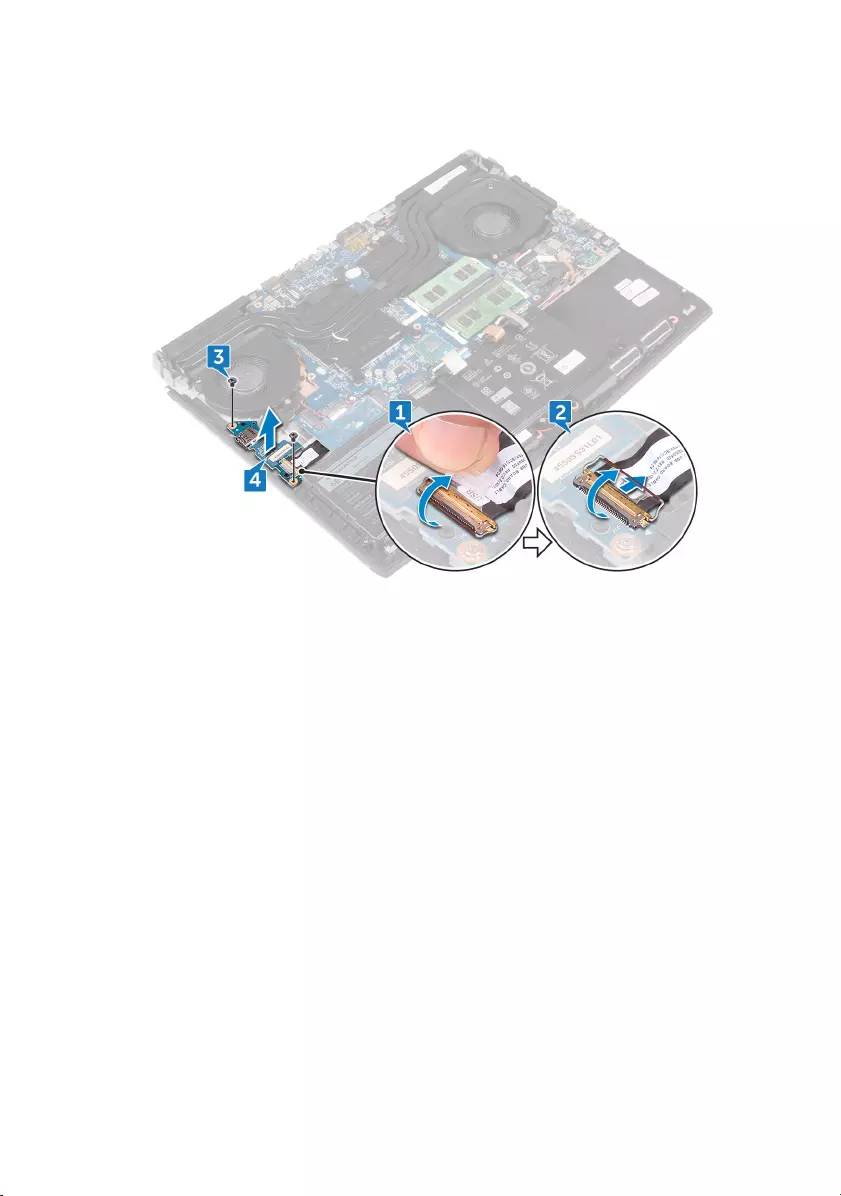
4 Lift the I/O board o the palm-rest assembly.
65

Replacing the I/O board
WARNING: Before working inside your computer, read the safety
information that shipped with your computer and follow the steps in
Before working inside your computer. After working inside your
computer, follow the instructions in After working inside your computer.
For more safety best practices, see the Regulatory Compliance home
page at www.dell.com/regulatory_compliance.
Procedure
1 Using the alignment posts, place the I/O board on the palm-rest assembly
and align the screw holes on the I/O board with the screw holes on the palm-
rest assembly.
2 Replace the two screws (M2.5x5) that secure the I/O board to the palm-rest
assembly.
3 Slide the I/O-board cable into the connector on the I/O board and close the
latch to secure the cable.
66

4 Adhere the tape that secures the I/O-board cable to the I/O board.
Post-requisites
1 Replace the computer base.
2 Replace the rear-I/O cover.
3 Replace the solid-state drive.
4 Follow the procedure from step 4 to step 6 in "Replacing the hard drive".
5 Replace the wireless card.
6 Replace the base cover.
67

Removing the speakers
WARNING: Before working inside your computer, read the safety
information that shipped with your computer and follow the steps in
Before working inside your computer. After working inside your
computer, follow the instructions in After working inside your computer.
For more safety best practices, see the Regulatory Compliance home
page at www.dell.com/regulatory_compliance.
Prerequisites
1 Remove the base cover.
2 Remove the wireless card.
3 Follow the procedure from step 1 to step 3 in "Removing the hard drive".
4 Remove the solid-state drive.
5 Remove the rear-I/O cover.
6 Remove the computer base.
7 Remove the battery.
Procedure
1 Disconnect the speaker cable from the system board.
2 Remove the speaker cable from the routing guides on the palm-rest assembly.
68

3 Lift the speakers along with its cable o the palm-rest assembly.
69

Replacing the speakers
WARNING: Before working inside your computer, read the safety
information that shipped with your computer and follow the steps in
Before working inside your computer. After working inside your
computer, follow the instructions in After working inside your computer.
For more safety best practices, see the Regulatory Compliance home
page at www.dell.com/regulatory_compliance.
Procedure
1 Using the alignment posts, place the speakers on the palm-rest assembly.
2 Route the speaker cable through the routing guides on the palm-rest
assembly.
3 Connect the speaker cable to the system board.
70

Removing the system board
WARNING: Before working inside your computer, read the safety
information that shipped with your computer and follow the steps in
Before working inside your computer. After working inside your
computer, follow the instructions in After working inside your computer.
For more safety best practices, see the Regulatory Compliance home
page at www.dell.com/regulatory_compliance.
NOTE: Your computer’s Service Tag is stored in the system board. You
must enter the Service Tag in the BIOS setup program after you replace
the system board.
NOTE: Replacing the system board removes any changes you have made
to the BIOS using the BIOS setup program. You must make the
appropriate changes again after you replace the system board.
NOTE: Before disconnecting the cables from the system board, note the
location of the connectors so that you can reconnect the cables correctly
after you replace the system board.
Prerequisites
1 Remove the base cover.
2 Remove the wireless card.
3 Follow the procedure from step 1 to step 3 in "Removing the hard drive".
4 Remove the solid-state drive.
5 Remove the rear-I/O cover.
6 Remove the computer base.
7 Remove the battery.
8 Remove the memory modules.
Procedure
1 Turn the computer over.
2 Peel the tape to access the display cable on the system board.
3 Open the latch and disconnect the display cable from the system board.
72
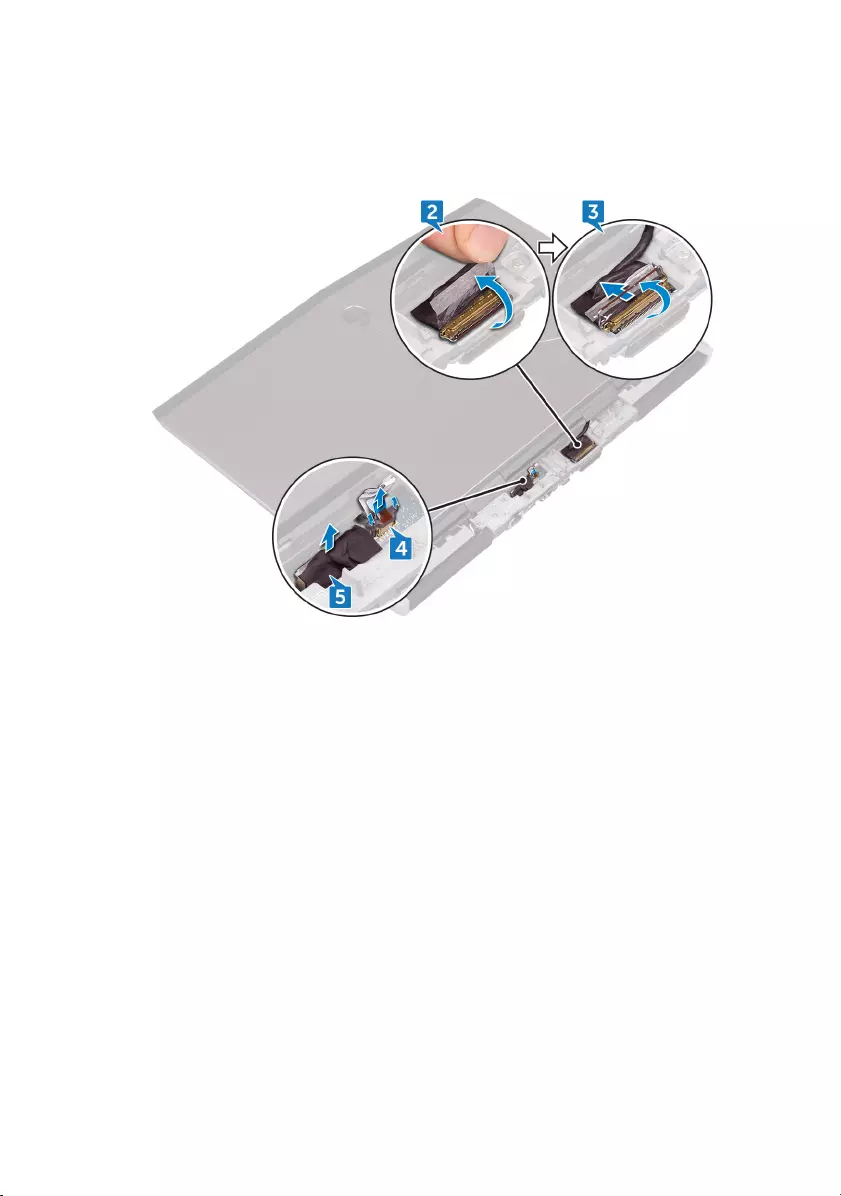
4 Open the latch and disconnect the power-button board cable from the
system board.
5 Disconnect the logo-board cable from the system board.
6 Turn the computer over.
7 Open the latch and disconnect the macro-keys backlight cable (optional)
from the system board.
8 Open the latch and disconnect the macro-keys cable (optional) from the
system board.
9 Open the latch and disconnect the keyboard-backlight cable (optional) from
the system board.
73

10 Open the latch and disconnect the keyboard cable (optional) from the system
board.
11 Disconnect the coin-cell battery cable from the system board.
12 Peel the tape to access the coin-cell battery cable on the system board.
13 Disconnect the power-adapter port cable from the system board.
14 Disconnect the speaker cable from the system board.
15 Open the latch and disconnect the RGB per key keyboard cable (optional)
from the system board.
16 Open the latch and disconnect the touchpad cable from the system board.
17 Peel the tape to access the I/O-board cable on the I/O board.
74
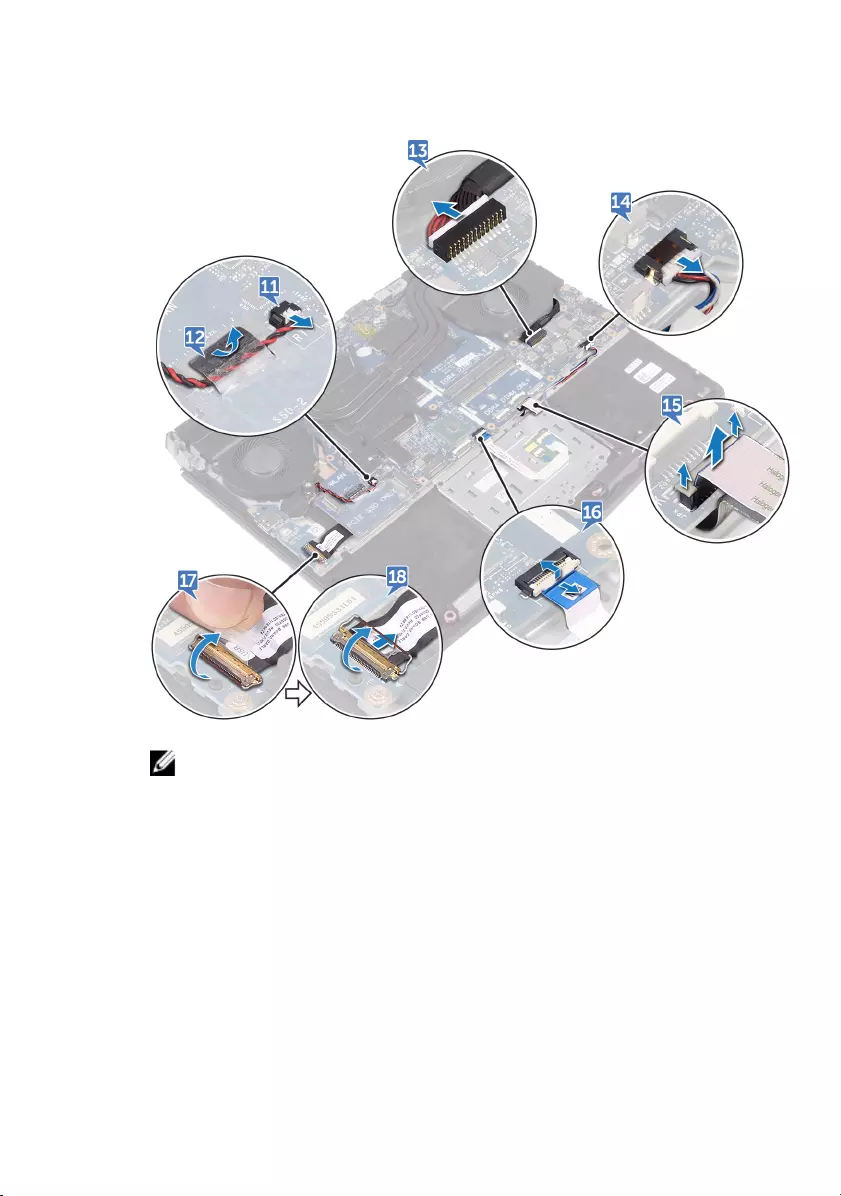
18 Open the latch and disconnect the I/O-board cable from the I/O board.
NOTE: Note the orientation of the USB Type-C port bracket before
removing it from the system board.
19 Remove the screw (M2.5x5) that secures the USB Type-C port bracket to the
system board and lift the USB Type-C port bracket o the system board.
20 Remove the six screws (M2.5x5) that secure the system-board assembly to
the palm-rest assembly.
75

24 After performing all the above steps, you are left with the system board.
77

Replacing the system board
WARNING: Before working inside your computer, read the safety
information that shipped with your computer and follow the steps in
Before working inside your computer. After working inside your
computer, follow the instructions in After working inside your computer.
For more safety best practices, see the Regulatory Compliance home
page at www.dell.com/regulatory_compliance.
NOTE: Your computer’s Service Tag is stored in the system board. You
must enter the Service Tag in the BIOS setup program after you replace
the system board.
NOTE: Replacing the system board removes any changes you have made
to the BIOS using the BIOS setup program. You must make the
appropriate changes again after you replace the system board.
Procedure
1 Replace the heat-sink assembly.
2 Connect the I/O cable to the back of the system board.
3 Align the screw holes on the system board with the screw holes on the palm-
rest assembly.
CAUTION: Make sure that no cables are under the system board.
4 Replace the six screws (M2.5x5) that secure the system-board assembly to
the palm-rest assembly.
78

5 Align the screw hole on the USB Type-C port bracket with the screw hole on
the system board and replace the screw (M2.5x5) that secures the USB Type-
C port bracket to the system board.
6 Slide the I/O-board cable into the connector on the I/O-board and close the
latch to secure the cable.
7 Adhere the tape that secures the I/O-board cable to the I/O board.
8 Slide the touchpad cable into the connector on the system board and close
the latch to secure the cable.
9 Connect the speaker cable to the system board.
10 Insert the RGB per key keyboard cable (optional) into the connector and
press down the latch to secure the cable.
11 Connect the power-adapter port cable to the system board.
12 Route the coin-cell battery through the routing channel and adhere the tape
to secure the cable.
79

13 Connect the coin-cell battery cable to the system board.
14 Connect the keyboard cable (optional) to the system board.
15 Connect the keyboard-backlight cable (optional) to the system board.
16 Connect the macro-keys cable (optional) to the system board.
80
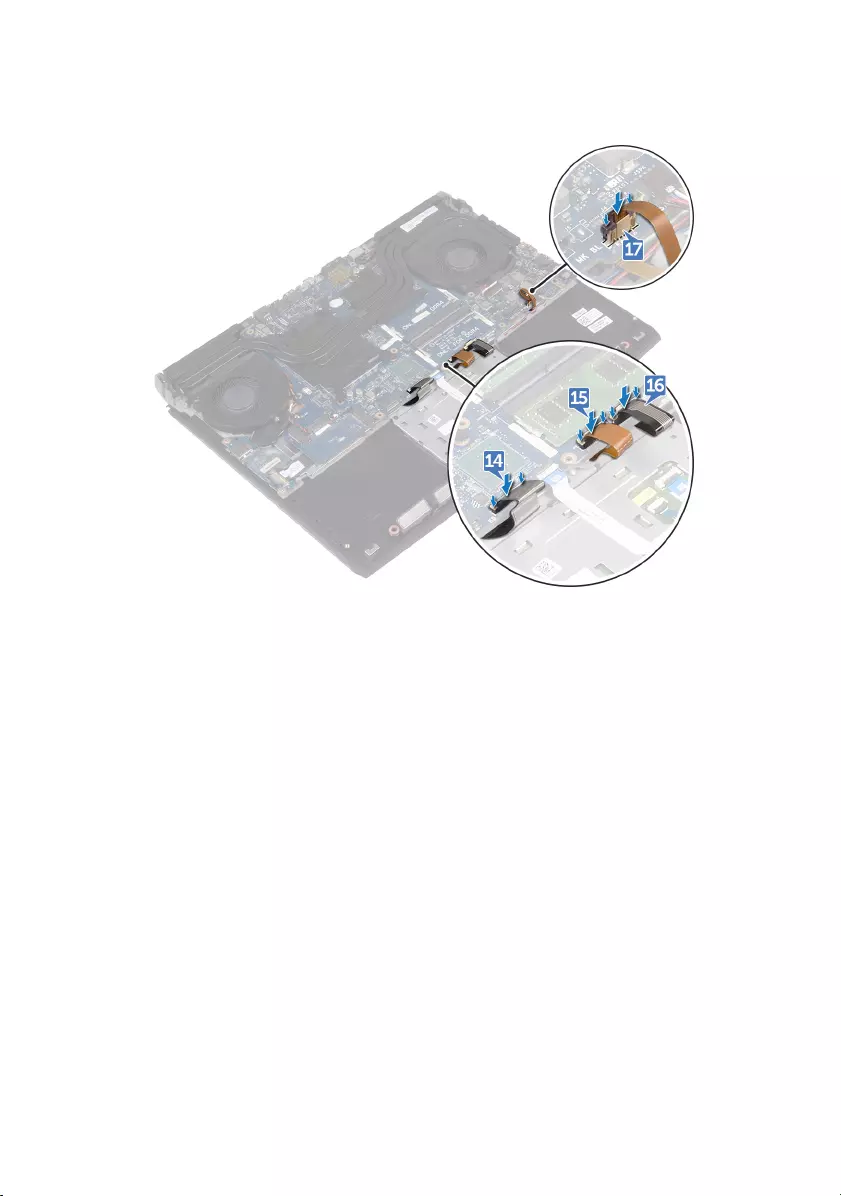
17 Connect the macro-keys backlight cable (optional) to the system board.
18 Turn the computer over.
19 Connect the logo-board cable to the system board.
20 Slide the power-button board cable into its slot on the system board and
close the latch to secure the cable.
21 Slide the display cable into the connector on the system board and close the
latch to secure the cable.
81

22 Adhere the tape that secures the display cable to the system board.
Post-requisites
1 Replace the memory modules.
2 Replace the battery.
3 Replace the computer base.
4 Replace the rear-I/O cover.
5 Replace the solid-state drive.
6 Follow the procedure from step 4 to step 6 in "Replacing the hard drive".
7 Replace the wireless card.
8 Replace the base cover.
82

Removing the keyboard
WARNING: Before working inside your computer, read the safety
information that shipped with your computer and follow the steps in
Before working inside your computer. After working inside your
computer, follow the instructions in After working inside your computer.
For more safety best practices, see the Regulatory Compliance home
page at www.dell.com/regulatory_compliance.
Prerequisites
1 Remove the base cover.
2 Remove the wireless card.
3 Follow the procedure from step 1 to step 3 in "Removing the hard drive".
4 Remove the solid-state drive.
5 Remove the rear-I/O cover.
6 Remove the computer base.
7 Remove the battery.
8 Remove the memory modules.
9 Follow the procedure from step 1 to step 21 in “Removing the system board”.
Procedure
1 Remove the 15 screws (M2x3) that secure the keyboard bracket to the palm-
rest assembly.
83

2 Lift the keyboard bracket o the palm-rest assembly.
84

3 Lift the keyboard at an angle and remove it from the tabs on the palm-rest
assembly.
85

Replacing the keyboard
WARNING: Before working inside your computer, read the safety
information that shipped with your computer and follow the steps in
Before working inside your computer. After working inside your
computer, follow the instructions in After working inside your computer.
For more safety best practices, see the Regulatory Compliance home
page at www.dell.com/regulatory_compliance.
Procedure
CAUTION: Ensure that there are no cables under the keyboard.
1 Slide the keyboard under the tabs on the palm-rest assembly.
2 Align the screw holes on the keyboard bracket with the screw holes on the
palm-rest assembly.
86
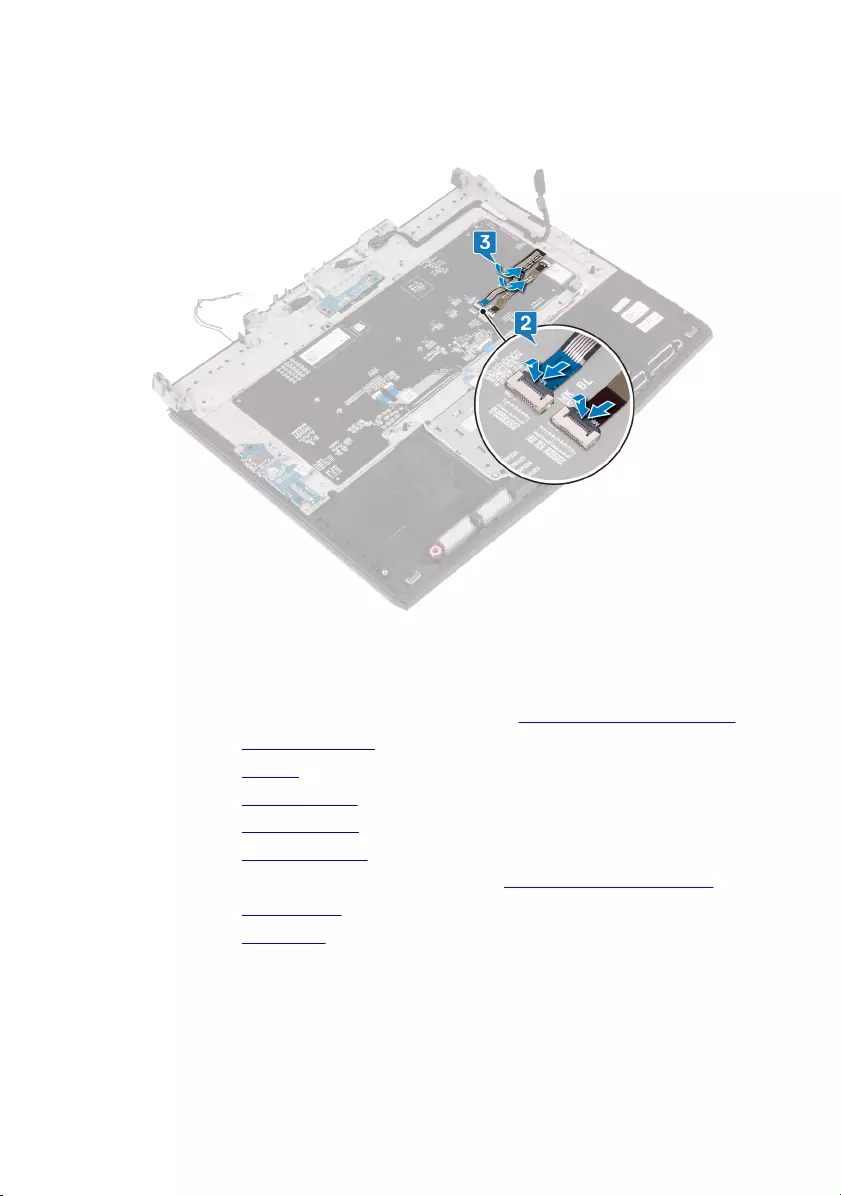
3 Replace the 15 screws (M2x3) that secure the keyboard bracket to the palm-
rest assembly.
Post-requisites
1 Follow the procedure from step 2 to step 16 in “Replacing the system board”.
2 Replace the memory modules.
3 Replace the battery.
4 Replace the computer base.
5 Replace the rear-I/O cover.
6 Replace the solid-state drive.
7 Follow the procedure from step 4 to step 6 in "Replacing the hard drive".
8 Replace the wireless card.
9 Replace the base cover.
87

Removing the macro keys
WARNING: Before working inside your computer, read the safety
information that shipped with your computer and follow the steps in
Before working inside your computer. After working inside your
computer, follow the instructions in After working inside your computer.
For more safety best practices, see the Regulatory Compliance home
page at www.dell.com/regulatory_compliance.
Prerequisites
1 Remove the base cover.
2 Remove the wireless card.
3 Follow the procedure from step 1 to step 3 in "Removing the hard drive".
4 Remove the solid-state drive.
5 Remove the rear-I/O cover.
6 Remove the computer base.
7 Remove the battery.
8 Remove the memory modules.
9 Follow the procedure from step 1 to step 21 in “Removing the system board”.
10 Remove the keyboard.
88

Procedure
Lift the macro keys at an angle, and release it from the tabs on the palm-rest
assembly.
89
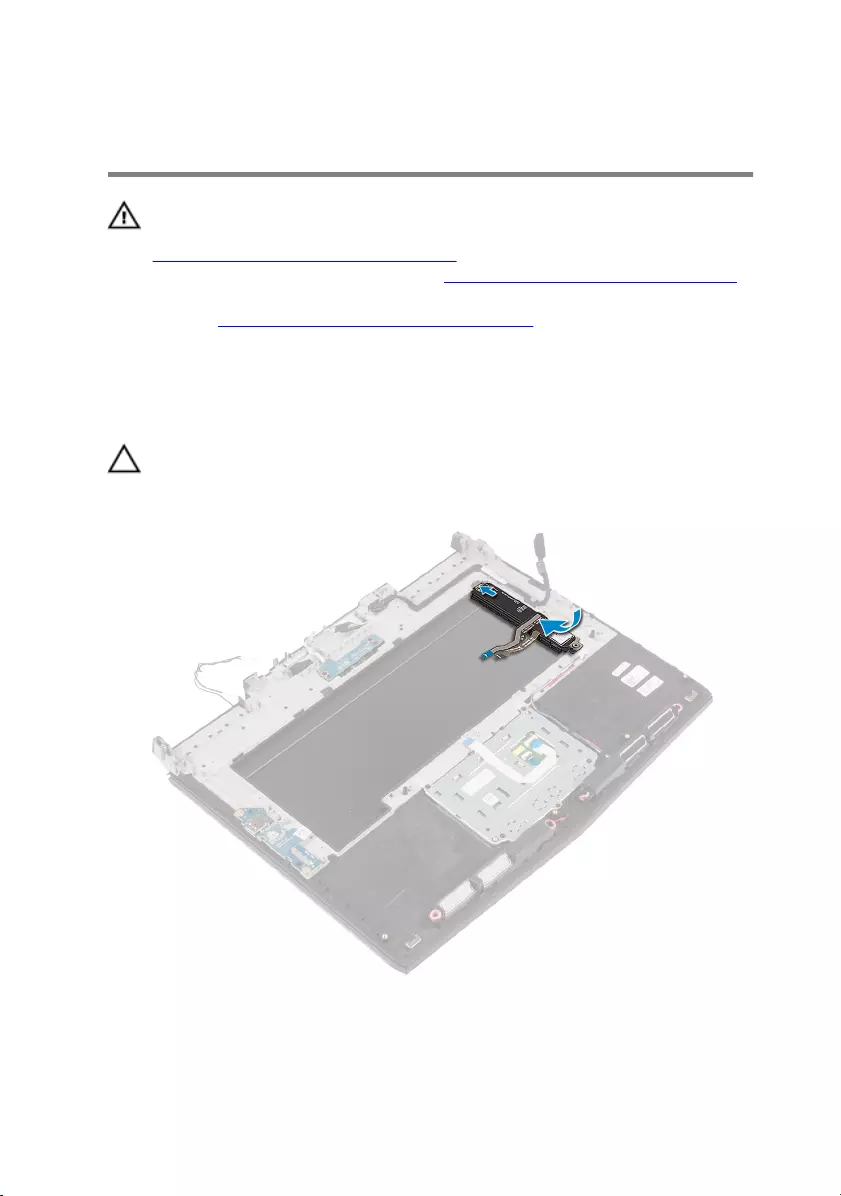
Replacing the macro keys
WARNING: Before working inside your computer, read the safety
information that shipped with your computer and follow the steps in
Before working inside your computer. After working inside your
computer, follow the instructions in After working inside your computer.
For more safety best practices, see the Regulatory Compliance home
page at www.dell.com/regulatory_compliance.
Procedure
CAUTION: Ensure that there are no cables under the macro keys.
Slide the macro keys under the tabs on the palm-rest assembly.
90

Post-requisites
1 Replace the keyboard.
2 Follow the procedure from step 2 to step 16 in “Replacing the system board”.
3 Replace the memory modules.
4 Replace the battery.
5 Replace the computer base.
6 Replace the rear-I/O cover.
7 Replace the solid-state drive.
8 Follow the procedure from step 4 to step 6 in "Replacing the hard drive".
9 Replace the wireless card.
10 Replace the base cover.
91

Removing the heat-sink assembly
WARNING: Before working inside your computer, read the safety
information that shipped with your computer and follow the steps in
Before working inside your computer. After working inside your
computer, follow the instructions in After working inside your computer.
For more safety best practices, see the Regulatory Compliance home
page at www.dell.com/regulatory_compliance.
WARNING: The heat sink may become hot during normal operation.
Allow sucient time for the heat sink to cool before you touch it.
CAUTION: For maximum cooling of the processor, do not touch the heat
transfer areas on the heat sink. The oils in your skin can reduce the heat
transfer capability of the thermal grease.
Prerequisites
1 Remove the base cover.
2 Remove the wireless card.
3 Follow the procedure from step 1 to step 3 in "Removing the hard drive".
4 Remove the solid-state drive.
5 Remove the rear-I/O cover.
6 Remove the computer base.
7 Remove the battery.
8 Remove the memory modules.
9 Follow the procedure from step 1 to step 21 in “Removing the system board”.
Procedure
1 Turn the system-board assembly over.
2 Disconnect the fan cable from the system board.
3 Peel o the tape that secures the fan cable to the system board.
4 Disconnect the fan cable from the system board.
92
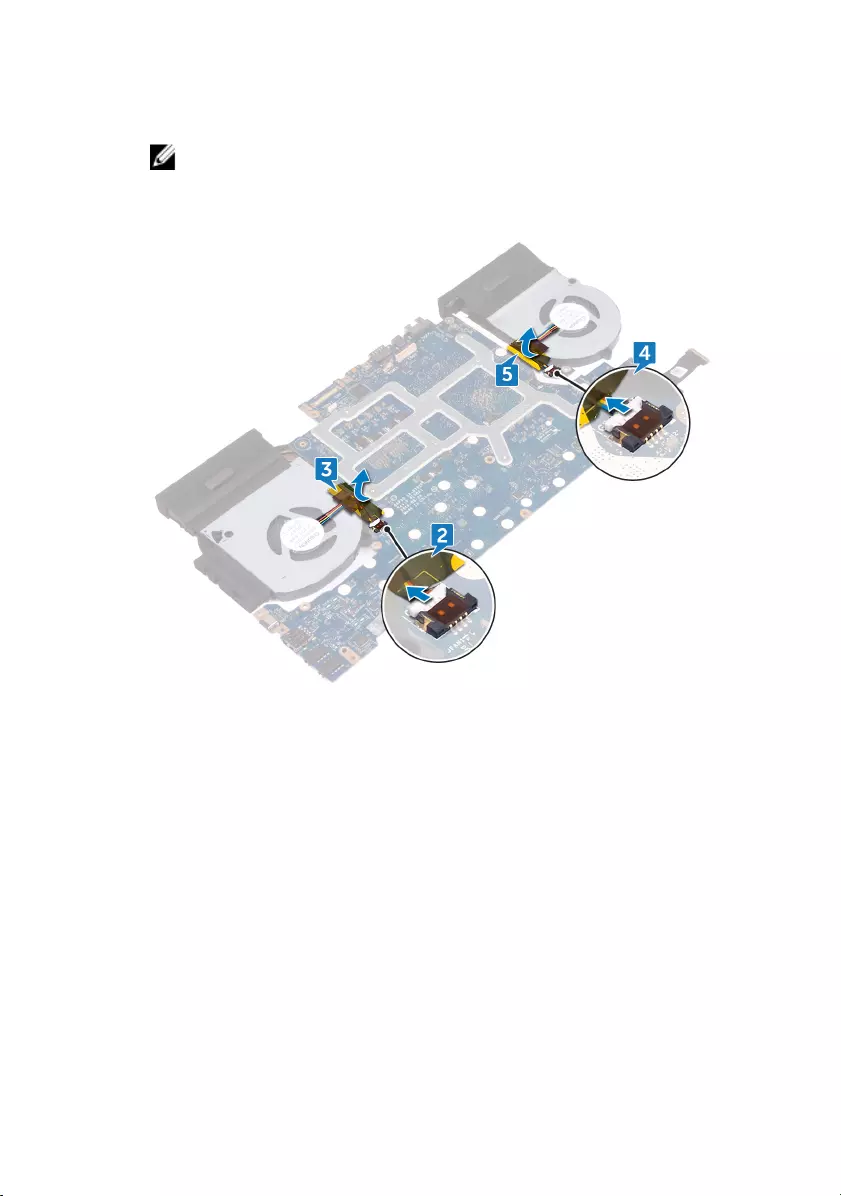
5 Peel o the tape that secures the fan cable to the system board.
NOTE: For computers shipped with NVIDIA GeForce GTX 1060
graphics controller, remove the fans after disconnecting the fan
cables from the system board.
6 Turn the system-board assembly over.
7 Remove the seven screws (M2x3) that secure the heat-sink assembly to the
system board.
93

8 Lift the heat-sink assembly o the system board.
94

Replacing the heat-sink assembly
WARNING: Before working inside your computer, read the safety
information that shipped with your computer and follow the steps in
Before working inside your computer. After working inside your
computer, follow the instructions in After working inside your computer.
For more safety best practices, see the Regulatory Compliance home
page at www.dell.com/regulatory_compliance.
CAUTION: Incorrect alignment of the heat sink can damage the system
board and processor.
NOTE: If either the system board or the fan and heat-sink assembly is
replaced, use the thermal pad provided in the kit to ensure that thermal
conductivity is achieved.
Procedure
1 Align the screw holes on the heat-sink assembly with the screw holes on the
system board.
95

2 Replace the seven screws (M2x3) that secure the heat-sink assembly to the
system board.
3 Turn the system-board assembly over.
NOTE: For computers shipped with NVIDIA GeForce GTX 1060
graphics controller, place the fans on the slots on the system board.
4 Connect the fan cable to the system board.
5 Adhere the tape that secures the fan cable to the system-board assembly.
6 Connect the fan cable to the system board.
96

7 Adhere the tape that secures the fan cable to the system-board assembly.
Post-requisites
1 Replace the memory modules.
2 Replace the battery.
3 Replace the computer base.
4 Replace the rear-I/O cover.
5 Replace the solid-state drive.
6 Follow the procedure from step 4 to step 6 in "Replacing the hard drive".
7 Replace the wireless card.
8 Replace the base cover.
97

Removing the power-adapter port
WARNING: Before working inside your computer, read the safety
information that shipped with your computer and follow the steps in
Before working inside your computer. After working inside your
computer, follow the instructions in After working inside your computer.
For more safety best practices, see the Regulatory Compliance home
page at www.dell.com/regulatory_compliance.
Prerequisites
1 Remove the base cover.
2 Remove the wireless card.
3 Follow the procedure from step 1 to step 3 in "Removing the hard drive".
4 Remove the solid-state drive.
5 Remove the rear-I/O cover.
6 Remove the computer base.
7 Remove the battery.
8 Remove the memory modules.
9 Follow the procedure from step 1 to step 21 in “Removing the system board”.
Procedure
1 Remove the screw (M2x3) that secures the power-adapter port bracket to the
palm-rest assembly.
2 Lift the power-adapter port bracket o the power-adapter port.
3 Lift the power-adapter port o the palm-rest assembly.
98

4 Note the routing and remove the power-adapter port cable from the routing
guides on the palm-rest assembly.
99

Replacing the power-adapter port
WARNING: Before working inside your computer, read the safety
information that shipped with your computer and follow the steps in
Before working inside your computer. After working inside your
computer, follow the instructions in After working inside your computer.
For more safety best practices, see the Regulatory Compliance home
page at www.dell.com/regulatory_compliance.
Procedure
1 Align the power-adapter port in the slot on the palm-rest assembly.
2 Align the screw hole on the power-adapter port bracket with the screw hole
on the palm-rest assembly.
3 Replace the screw (M2x3) that secures the power-adapter port bracket to
the palm-rest assembly.
100

4 Route the power-adapter port cable through the routing guides on the palm-
rest assembly.
Post-requisites
1 Follow the procedure from step 2 to step 16 in “Replacing the system board”.
2 Replace the memory modules.
3 Replace the battery.
4 Replace the computer base.
5 Replace the rear-I/O cover.
6 Replace the solid-state drive.
7 Follow the procedure from step 4 to step 6 in "Replacing the hard drive".
8 Replace the wireless card.
9 Replace the base cover.
101

Removing the power-button board
WARNING: Before working inside your computer, read the safety
information that shipped with your computer and follow the steps in
Before working inside your computer. After working inside your
computer, follow the instructions in After working inside your computer.
For more safety best practices, see the Regulatory Compliance home
page at www.dell.com/regulatory_compliance.
Prerequisites
1 Remove the base cover.
2 Remove the wireless card.
3 Follow the procedure from step 1 to step 3 in "Removing the hard drive".
4 Remove the solid-state drive.
5 Remove the rear-I/O cover.
6 Remove the computer base.
7 Remove the battery.
8 Remove the memory modules.
9 Follow the procedure from step 1 to step 21 in “Removing the system board”.
Procedure
1 Remove the two screws (M2x3) that secure the power-button board to the
palm-rest assembly.
102

2 Lift the power-button board along with its cable o the palm-rest assembly.
103

Replacing the power-button board
WARNING: Before working inside your computer, read the safety
information that shipped with your computer and follow the steps in
Before working inside your computer. After working inside your
computer, follow the instructions in After working inside your computer.
For more safety best practices, see the Regulatory Compliance home
page at www.dell.com/regulatory_compliance.
Procedure
1 Align the screw holes on the power-button board with the screw holes on the
palm-rest assembly.
2 Replace the two screws (M2x3) that secure the power-button board to the
palm-rest assembly.
104

Post-requisites
1 Follow the procedure from step 2 to step 16 in “Replacing the system board”.
2 Replace the memory modules.
3 Replace the battery.
4 Replace the computer base.
5 Replace the rear-I/O cover.
6 Replace the solid-state drive.
7 Follow the procedure from step 4 to step 6 in "Replacing the hard drive".
8 Replace the wireless card.
9 Replace the base cover.
105

Removing the palm rest
WARNING: Before working inside your computer, read the safety
information that shipped with your computer and follow the steps in
Before working inside your computer. After working inside your
computer, follow the instructions in After working inside your computer.
For more safety best practices, see the Regulatory Compliance home
page at www.dell.com/regulatory_compliance.
Prerequisites
1 Remove the base cover.
2 Remove the wireless card.
3 Remove the memory modules.
4 Follow the procedure from step 1 to step 3 in "Removing the hard drive".
5 Remove the solid-state drive.
6 Remove the rear-I/O cover.
7 Remove the computer base.
8 Remove the coin-cell battery.
9 Remove the battery.
10 Remove the touch pad.
11 Remove the I/O board.
12 Remove the speakers.
13 Follow the procedure from step 1 to step 21 in “Removing the system board”.
14 Remove the display assembly.
15 Remove the keyboard.
16 Remove the power-adapter port.
17 Remove the power-button board .
106

Procedure
After performing all the prerequisites, we are left with the palm rest.
107

Replacing the palm rest
WARNING: Before working inside your computer, read the safety
information that shipped with your computer and follow the steps in
Before working inside your computer. After working inside your
computer, follow the instructions in After working inside your computer.
For more safety best practices, see the Regulatory Compliance home
page at www.dell.com/regulatory_compliance.
Procedure
Place the palm rest on a at surface.
Post-requisites
1 Replace the power-button board.
2 Replace the power-adapter port.
3 Replace the keyboard.
4 Replace the display assembly.
5 Follow the procedure from step 2 to step 16 in “Replacing the system board”.
6 Replace the speakers.
7 Replace the I/O board.
8 Replace the touch pad.
9 Replace the battery.
10 Replace the coin-cell battery.
11 Replace the computer base.
12 Replace the rear-I/O cover.
13 Replace the memory modules.
14 Replace the solid-state drive.
15 Follow the procedure from step 4 to step 6 in "Replacing the hard drive".
16 Replace the wireless card.
17 Replace the base cover.
108

Removing the display assembly
WARNING: Before working inside your computer, read the safety
information that shipped with your computer and follow the steps in
Before working inside your computer. After working inside your
computer, follow the instructions in After working inside your computer.
For more safety best practices, see the Regulatory Compliance home
page at www.dell.com/regulatory_compliance.
Prerequisites
1 Remove the base cover.
2 Remove the wireless card.
3 Follow the procedure from step 1 to step 3 in "Removing the hard drive".
4 Remove the solid-state drive.
5 Remove the rear-I/O cover.
6 Remove the computer base.
7 Remove the battery.
8 Remove the memory modules.
9 Follow the procedure from step 1 to step 21 in “Removing the system board”.
109

Procedure
1 Carefully pull the antenna cables out from the gap between the system board
and the palm-rest assembly.
2 Turn the computer over.
3 Disconnect the logo-board cable from the system board.
4 Peel the tape to access the display cable.
110

5 Open the latch, and disconnect the display cable from the system board.
6 Remove the six screws (M2.5x5) that secure the display assembly to the palm-
rest assembly.
111

7 Lift the display assembly o the computer base.
112

Replacing the display assembly
WARNING: Before working inside your computer, read the safety
information that shipped with your computer and follow the steps in
Before working inside your computer. After working inside your
computer, follow the instructions in After working inside your computer.
For more safety best practices, see the Regulatory Compliance home
page at www.dell.com/regulatory_compliance.
Procedure
1 Align the screw holes on the display hinges with the screw holes on the palm-
rest assembly.
2 Replace the six screws (M2.5x5) that secure the display assembly to the palm-
rest assembly.
3 Push the antenna cables through the gap between the display assembly and
the system board to reach the other side of the system board.
113

4 Connect the logo-board cable to the system board.
5 Slide the display cable into the connector on the system board and close the
latch to secure the cable.
6 Adhere the tape that secures the display cable to the system board.
7 Turn the computer over.
114
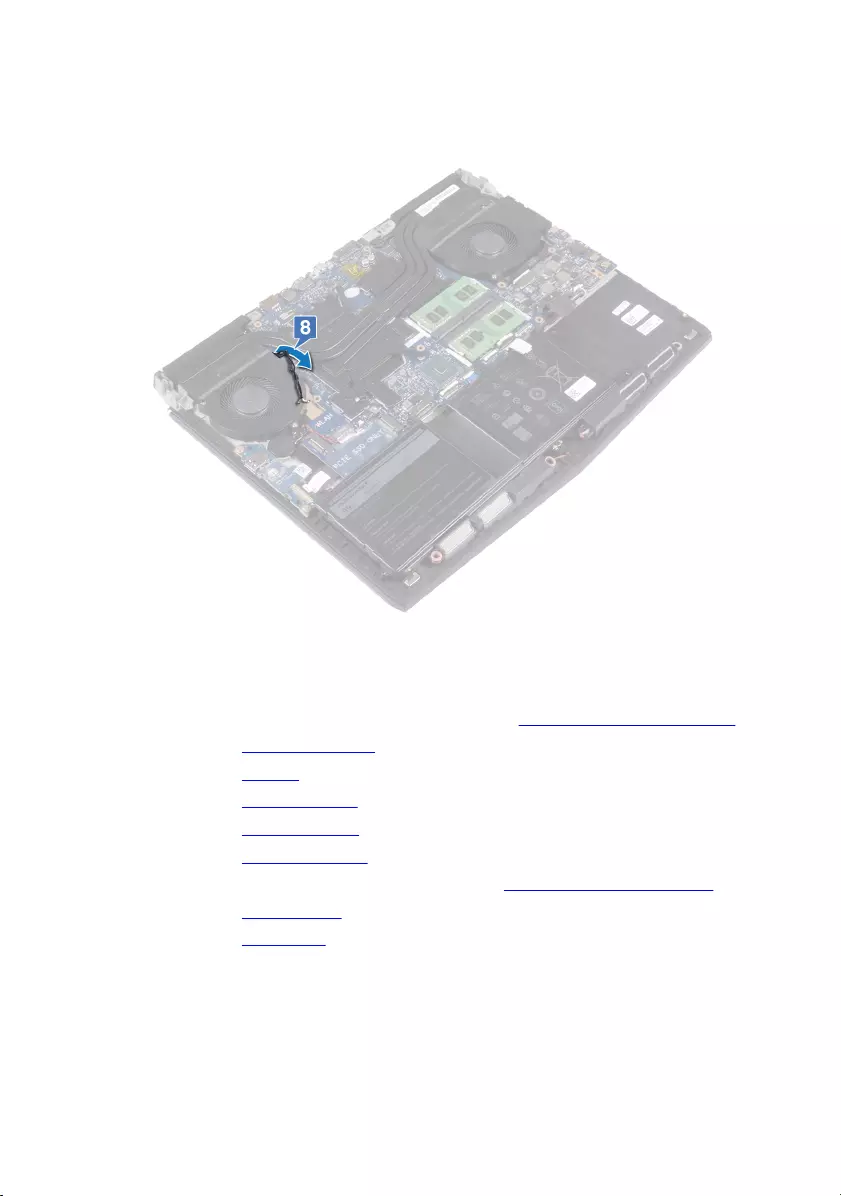
8 Push the antenna cables through the gap between the system board and the
palm-rest assembly one by one.
Post-requisites
1 Follow the procedure from step 2 to step 16 in “Replacing the system board”.
2 Replace the memory modules.
3 Replace the battery.
4 Replace the computer base.
5 Replace the rear-I/O cover.
6 Replace the solid-state drive.
7 Follow the procedure from step 4 to step 6 in "Replacing the hard drive".
8 Replace the wireless card.
9 Replace the base cover.
115

Downloading drivers
Operating system
• Windows 10 Home (64-bit)
• Windows 10 Professional (64-bit)
Downloading the audio driver
1 Turn on your computer.
2 Go to www.dell.com/support.
3 Click Product support, enter the Service Tag of your computer, and then
click Submit.
NOTE: If you do not have the Service Tag, use the auto-detect
feature or manually browse for your computer model.
4 Click Drivers & downloads → Find it myself.
5 Scroll down the page, and expand Audio.
6 Click Download to download the audio driver for your computer.
7 After the download is complete, navigate to the folder where you saved the
audio driver le.
8 Double-click the audio driver le icon and follow the instructions on the
screen to install the driver.
Table 3. Audio controller in device manager
Before driver installation After driver installation
Downloading the graphics driver
1 Turn on your computer.
2 Go to www.dell.com/support.
116

3 Click Product support enter the Service Tag of your computer, and then click
Submit.
NOTE: If you do not have the Service Tag, use the auto-detect
feature or manually browse for your computer model.
4 Click Drivers & downloads → Find it myself.
5 Scroll down the page, and expand Video.
6 Click Download to download the graphics driver for your computer.
7 After the download is complete, navigate to the folder where you saved the
graphics driver le.
8 Double-click the graphics driver le icon, and follow the instructions on the
screen.
Table 4. Display adapter in device manager
Before driver installation After driver installation
Downloading the USB driver
1 Turn on your computer.
2 Go to www.dell.com/support.
3 Click Product support enter the Service Tag of your computer, and then click
Submit.
NOTE: If you do not have the Service Tag, use the auto-detect
feature or manually browse for your computer model.
4 Click Drivers & downloads → Find it myself.
5 Scroll down the page and expand Chipset.
6 Click Download to download the USB driver for your computer.
7 After the download is complete, navigate to the folder where you saved the
USB driver le.
117

8 Double-click the driver le icon and follow the instructions on screen.
Table 5. Universal Serial Bus controllers in device manager
Before driver installation After driver installation
Downloading the Wi-Fi driver
1 Turn on your computer.
2 Go to www.dell.com/support.
3 Click Product support enter the Service Tag of your computer, and then click
Submit.
NOTE: If you do not have the Service Tag, use the auto-detect
feature or manually browse for your computer model.
4 Click Drivers & downloads → Find it myself.
5 Scroll down the page, and expand Network.
6 Click Download to download the Wi-Fi driver for your computer.
7 After the download is complete, navigate to the folder where you saved the
Wi-Fi driver le.
118

8 Double-click the driver le icon and follow the on-screen instructions to
install the driver.
Table 6. Network adapter in device manager
Before driver installation After driver installation
Downloading the media-card reader driver
1 Turn on your computer.
2 Go to www.dell.com/support.
3 Click Product support, enter the Service Tag of your computer, and then
click Submit.
NOTE: If you do not have the Service Tag, use the auto-detect
feature or manually browse for your computer model.
4 Click Drivers & downloads → Find it myself.
5 Scroll down the page, and expand Chipset.
6 Click Download to download the media-card reader driver for your
computer.
7 After the download is complete, navigate to the folder where you saved the
card reader driver le.
119

8 Double-click the card reader driver le icon, and follow the instructions on
the screen.
Table 7. Identifying media-card reader driver in device manager
Before driver installation After driver installation
Downloading the chipset driver
1 Turn on your computer.
2 Go to www.dell.com/support.
3 Click Product support, enter the Service Tag of your computer, and then
click Submit.
NOTE: If you do not have the Service Tag, use the auto-detect
feature or manually browse for your computer model.
4 Click Drivers & downloads → Find it myself.
5 Scroll down the page and expand Chipset.
6 Click Download to download the chipset driver for your computer.
7 After the download is complete, navigate to the folder where you saved the
chipset driver le.
8 Double-click the chipset driver le icon and follow the instructions on the
screen.
Downloading the network driver
1 Turn on your computer.
2 Go to www.dell.com/support.
3 Click Product support enter the Service Tag of your computer and click
Submit.
NOTE: If you do not have the Service Tag, use the auto-detect
feature or manually browse for your computer model.
120

4 Click Drivers & downloads → Find it myself.
5 Scroll down the page and expand Network.
6 Click Download to download the network driver for your computer.
7 Save the le, and after the download is complete, navigate to the folder
where you saved the network driver le.
8 Double-click the network driver le icon and follow the instructions on
screen.
Table 8. Identifying network driver in device manager
Before driver installation After driver installation
121

System setup
NOTE: Depending on the computer and its installed devices, the items
listed in this section may or may not be displayed.
Boot Sequence
Boot Sequence allows you to bypass the System Setup–dened boot device order
and boot directly to a specic device (for example: optical drive or hard drive).
During the Power-on Self Test (POST), when the Dell logo appears, you can:
• Access System Setup by pressing F2 key
• Bring up the one-time boot menu by pressing F12 key
The one-time boot menu displays the devices that you can boot from including the
diagnostic option. The boot menu options are:
• Removable Drive (if available)
• STXXXX Drive
NOTE: XXX denotes the SATA drive number.
• Optical Drive (if available)
• SATA Hard Drive (if available)
• Diagnostics
NOTE: Choosing Diagnostics, will display the ePSA diagnostics
screen.
The boot sequence screen also displays the option to access the System Setup
screen.
Navigation keys
NOTE: For most of the System Setup options, changes that you make are
recorded but do not take eect until you restart the system.
122

Keys Navigation
Up arrow Moves to the previous eld.
Down arrow Moves to the next eld.
Enter Selects a value in the selected eld (if applicable) or follow
the link in the eld.
Spacebar Expands or collapses a drop‐down list, if applicable.
Tab Moves to the next focus area.
NOTE: For the standard graphics browser only.
Esc Moves to the previous page until you view the main screen.
Pressing Esc in the main screen displays a message that
prompts you to save any unsaved changes and restarts the
system.
BIOS overview
CAUTION: Unless you are an expert computer user, do not change the
settings in the BIOS Setup program. Certain changes can make your
computer work incorrectly.
NOTE: Before you change BIOS Setup program, it is recommended that
you write down the BIOS Setup program screen information for future
reference.
Use the BIOS Setup program for the following purposes:
• Get information about the hardware installed in your computer, such as the
amount of RAM and the size of the hard drive.
• Change the system conguration information.
• Set or change a user-selectable option, such as the user password, type of hard
drive installed, and enabling or disabling base devices.
Entering BIOS setup program
1 Turn on (or restart) your computer.
123

2 During POST, when the DELL logo is displayed, watch for the F2 prompt to
appear, and then press F2 immediately.
NOTE: The F2 prompt indicates that the keyboard is initialized. This
prompt can appear very quickly, so you must watch for it, and then
press F2. If you press F2 before the F2 prompt, this keystroke is lost.
If you wait too long and the operating system logo appears, continue
to wait until you see the desktop. Then, turn o your computer and
try again.
Enabling or disabling the USB in BIOS setup program
1 Turn on or restart your computer.
2 Press F2 when the Dell logo is displayed on the screen to enter the BIOS
setup program.
The BIOS setup program is displayed.
3 On the left pane, select Settings → System Conguration → USB
Conguration.
The USB conguration is displayed on the right pane.
4 Select or clear the Enable External USB Port check box to enable or disable
it, respectively.
5 Save the settings and exit.
Identifying the hard drive in BIOS setup program
1 Turn on or restart your computer.
2 Press F2 when the Dell logo is displayed on the screen to enter the BIOS
setup program.
A list of hard drives are displayed under the System Information in the
General group.
Checking the system memory in BIOS setup program
1 Turn on or restart your computer.
2 Press F2 when the Dell logo is displayed to enter the BIOS setup program.
3 On the left pane, select Settings → General → System Information.
The memory information is displayed on the right pane.
124

System setup options
NOTE: Depending on your computer and its installed devices, the items
listed in this section may or may not appear.
Table 9. System setup options—Main menu
Main
System Time Displays the current time in hh:mm:ss
format.
System Date Displays the current date in mm/dd/
yyyy format.
BIOS Version Displays the BIOS version.
Product Name Displays the model number of your
computer.
Service Tag Displays the service tag of your
computer.
Asset Tag Displays the asset tag of your
computer.
CPU Type Displays the processor type.
CPU Speed Displays the processor speed.
CPU ID Displays the processor identication
code.
CPU L1 Cache Displays the processor L1 cache size.
CPU L2 Cache Displays the processor L2 cache size.
CPU L3 Cache Displays the processor L3 cache size.
Integrated Graphics Displays the integrated graphics.
Discrete Graphics 1 Displays the rst discrete graphics
installed on your computer.
Discrete Graphics 1 Displays the second discrete graphics
installed on your computer.
First HDD Displays the type of hard drive
installed.
125

Main
Second HDD Displays the type of secondary hard-
drive installed.
Third HDD Displays the type of third hard-drive
installed.
M.2 PCIe SSD-1 Displays the type of primary SSD
installed.
M.2 PCIe SSD-2 Displays the type of secondary SSD
installed.
M.2 PCIe SSD-3 Displays the type of third SSD
installed.
AC Adapter Type Displays the AC adapter type.
Table 10. System setup options—Advanced menu
Advanced
Intel(R) SpeedStep(TM) Enables you to enable or disable Intel
Speedstep Technology.
Default: Enabled
NOTE: If enabled, the processor
clock speed and core voltage are
adjusted dynamically based on
the processor load.
Virtualization Enables you to enable or disable Intel
Virtualization Technology feature for
the processor.
Default: Enabled
VT for Direct I/O Specify whether a Virtual Machine
Monitor (VMM) can utilize the
additional hardware capabilities
provided by Intel Virtualization
Technology for Direct I/O.
Trusted Execution Specify whether a Virtual Machine
Monitor (VMM) can utilize the
additional hardware capabilities
126

Advanced
provided by Intel Trusted Execution
Technology.
Default: Disabled
Integrated NIC Enables you to enable or disable the
on-board LAN controller.
Default: Enabled
USB Emulation Enables you to enable or disable the
USB emulation feature. This feature
denes how the BIOS, in the absence
of a USB-aware operating system,
handles USB devices. USB emulation is
always enabled during POST.
Default: Enabled
NOTE: You cannot boot any
type of USB device (oppy,
hard drive, or memory key)
when this option is o.
USB Powershare Enables you to charge USB devices
when the computer is turned o or in
standby mode.
Default: Enabled
USB Wake Support Enables you to enable the USB
devices to wake the computer from
Standby.
Default: Disabled
NOTE: If USB PowerShare is
enabled, a device connected to
the USB PowerShare connector
may not wake the computer.
Intel Speed Shift Technology Enable/disable Intel Speed Shift
Technology support. Setting this
option to enable to allows the
operating system to select the
appropriate processor performance
automatically.
Default: Enabled
127

Advanced
SATA Operation Enables you to congure the
operating mode of the integrated
SATA hard drive controller.
Default: AHCI
Adapter Warnings Ebales you to choose if the computer
should display warning messages when
you use AC adapters that are not
supported by your computer.
Default: Enabled
Function Key Behavior Enables you to set function key or
multimedia key as the default function
key behavior.
Default: Function key
Express Charge Enables you to charge your computer
battery using Standard Charge or
Express Charge mode.
Default: Express Charge
Touchpad Backlight Enables you to congure the
touchpad backlight option.
Default: Auto
Battery Health Displays the battery health.
Intel(R) Software Guard
Extensions
Enable or disable Intel Software
Guard Extensions.
Default: Software Controlled
Intel(R) Software Guard
Extensions allocated memory size
Displays the allocated memory size for
Intel Software Guard Extensions.
BIOS Recovery from Hard Drive Enable the user to recover from
certain corrupted BIOS conditions
from a recovery le on the user
primary hard drive
Default: Enabled
BIOS Auto-Recovery Enable or disable BIOS Auto-
Recovery.
Default: Disabled
128

Advanced
Always Perform Integrity Check Enable or disable Always Perform
Integrity Check.
Default: Disabled
Performance Options
CPU Performance Mode Enables you to select the CPU
performance mode.
Default: Enabled
Fan Performance Mode Enables you to select the fan
performance mode.
Default: Balanced Mode
Core Over Clocking Level Enable or disable the over-clocking
setting and adjust the processor ex
ratio and voltage in the Customization
mode.
Default: Disabled
SupportAssist System Resolution
Auto OS Recovery Threshold Control the automatic boot ow for
SupportAssist System Resolution
Console and for Dell OS Recovery
tool.
Default: 2
SupportAssist OS Recovery Enable or disable SupportAssist OS
recovery.
Default: Enabled
Intel(R) Rapid Storage Technology
Non-RAID Physical Disks Displays the disk using the Intel(R)
Rapid Storage Technology.
129

Table 11. System setup options—Security menu
Security
Unlock Setup Status Displays if the setup status is
unlocked.
Admin Password Status Displays if the administrator password
is clear or set.
Default: Not set
System Password Status Displays if the system password is
clear or set.
Default: Not set
HDD Password Status Displays if the HDD password is clear
or set.
Default: Not set
Admin Password Enables you to set the administrator
password. The administrator password
controls access to the system setup
utility.
System Password Enables you to set the system
password. The system password
controls access to the computer at
boot.
HDD password Enables you to set, change or delete
the hard-disk drive password.
Password Change Enables you to permit or deny system
password or HDD password changes.
Default: Permitted
Computrace Enable or disable the BIOS module
interface of the optional Computrace
Service from Absolute Software.
Default: Activate
Firmware TPM Enables you to enable or disable the
rmware TPM function.
Default: Enabled
PPI Bypass for Clear Command Enables you to control the TPM
Physical Presence Interface (PPI).
130

Security
When enabled, this setting will allow
the OS to skip BIOS PPI user prompts
when issuing the Clear command.
Changes to this setting take eect
immediately.
Default: Enabled
UEFI Capsule Firmware Updates Enable or disable BIOS updates
through UEFI capsule update
packages.
Default: Enabled
Table 12. System setup options—Boot menu
Boot
Boot List Option Displays the available boot options.
Default: UEFI
File Browser Add Boot Option Enables you to add the boot options.
File Browser Del Boot Option Enables you to delete the boot
options
Secure Boot Enable or disable the secure boot
feature.
Default: Disabled
Legacy Option ROMs Enable or disable the Legacy Option
ROMs.
Default: Disabled
Attempt Legacy Boot Enable or disable Attempt Legacy
Boot.
Default: Disabled
Boot Option Priorities Displays the boot sequence.
Boot Option #1 Displays the available rst boot
option.
Boot Option #2 Displays the available second boot
option.
131

Boot
Boot Option #3 Displays the available third boot
option.
Table 13. System setup options—Exit menu
Exit
Save Changes and Reset Allows you to exit system setup and
save your changes.
Discard Changes and Reset Allows you to exit system setup and
load previous values for all system
setup options.
Restore Defaults Allows you to restore default values
for all system setup options.
Discard Changes Allows you to load previous values for
all system setup options.
Save Changes Allows you to save the changes for all
system setup options.
132

Troubleshooting
Flashing the BIOS
You may need to ash (update) the BIOS when an update is available or when you
replace the system board.
Follow these steps to ash the BIOS:
1 Turn on your computer.
2 Go to www.dell.com/support.
3 Click Product support, enter the Service Tag of your computer, and then
click Submit.
NOTE: If you do not have the Service Tag, use the auto-detect
feature or manually browse for your computer model.
4 Click Drivers & downloads → Find it myself.
5 Select the operating system installed on your computer.
6 Scroll down the page and expand BIOS.
7 Click Download to download the latest version of the BIOS for your
computer.
8 After the download is complete, navigate to the folder where you saved the
BIOS update le.
9 Double-click the BIOS update le icon and follow the instructions on the
screen.
Flashing BIOS (USB key)
1 Follow the procedure from step 1 to step 7 in "Flashing the BIOS" to
download the latest BIOS setup program le.
2 Create a bootable USB drive. For more information see the knowledge base
article SLN143196 at www.dell.com/support.
3 Copy the BIOS setup program le to the bootable USB drive.
4 Connect the bootable USB drive to the computer that needs the BIOS
update.
5 Restart the computer and press F12 when the Dell logo is displayed on the
screen.
133

6 Boot to the USB drive from the One Time Boot Menu.
7 Type the BIOS setup program lename and press Enter.
8 The BIOS Update Utility appears. Follow the instructions on the screen to
complete the BIOS update.
Reinstall Windows using a USB recovery
drive
CAUTION: This process formats the hard drive and removes all data on
your computer. Ensure that you back up data on your computer before
beginning this task.
NOTE: Before reinstalling Windows, ensure your computer has more than
2 GB of memory and more than 32 GB of storage space.
NOTE: This process may take up to an hour to complete and your
computer will restart during the recovery process.
1 Connect the USB recovery drive to your computer.
2 Restart your computer.
3 Press F12 after the Dell logo is displayed on the screen to access the boot
menu.
A Preparing one-time boot menu message appears.
4 After the boot menu loads, select the USB recovery device under UEFI
BOOT.
The system reboots and a screen to Choose the keyboard layout is displayed.
5 Choose your keyboard layout.
6 In the Choose an option screen, click Troubleshoot.
7 Click Recover from a drive.
8 Choose one of the following options:
–Just remove my les to do a quick format.
–Fully clean the drive to do a complete format.
9 Click Recover to start the recovery process.
134

Enhanced Pre-Boot System Assessment
(ePSA) diagnostics
CAUTION: Use the ePSA diagnostics to test only your computer. Using
this program with other computers may cause invalid results or error
messages.
The ePSA diagnostics (also known as system diagnostics) performs a complete
check of your hardware. The ePSA is embedded with the BIOS and is launched by
the BIOS internally. The embedded system diagnostics provides a set of options for
particular devices or device groups allowing you to:
• Run tests automatically or in an interactive mode
• Repeat tests
• Display or save test results
• Run thorough tests to introduce additional test options to provide extra
information about the failed device(s)
• View status messages that inform you if tests are completed successfully
• View error messages that inform you of problems encountered during testing
NOTE: Some tests for specic devices require user interaction. Always
ensure that you are present at the computer terminal when the diagnostic
tests are performed.
For more information, see Dell EPSA Diagnostic 3.0.
Running the ePSA diagnostics
1 Power-on the computer.
2 As the computer boots, press the F12 key as the Dell logo appears.
3 On the boot menu screen, select the Diagnostics option.
4 Click the arrow key at the bottom left corner.
Diagnostics front page is displayed.
5 Press the arrow in the lower-right corner to go to the page listing.
The items detected are listed.
6 To run a diagnostic test on a specic device, press Esc and click Yes to stop
the diagnostic test.
7 Select the device from the left pane and click Run Tests.
135

8 If there are any issues, error codes are displayed.
Note the error code and validation number and contact Dell.
Diagnostics
Power and battery-status light: Indicates the power and battery-charge status.
Solid amber – Computer is running on battery and the battery has less than 10
percent charge.
User-dened color (AC mode) – Power adapter is connected and the battery is
fully charged.
User-dened color (Battery mode) – Computer is running on battery and the
battery has more than 10 percent charge.
User-dened color (Breath) – Computer is in sleep state.
O – Computer is in hibernation, or turned o.
The power and battery-status light blinks red and blue along with beep codes
indicating failures.
For example, the power and battery-status light blinks red two times followed by a
pause, and then blinks blue three times followed by a pause. This 2,3 pattern
continues until the computer is turned o indicating no memory or RAM is
detected.
The following table shows dierent light patterns and what they indicate.
Table 14. Diagnostics
Light Pattern Problem description
2,1 CPU failure
2,2 System board: BIOS and ROM failure
2,3 No memory or RAM detected
2,4 Memory or RAM failure
2,5 Invalid memory installed
2,6 System board or chipset error
2,7 LCD failure
3,1 CMOS battery failure
3,2 PCI/video card failure
136

Light Pattern Problem description
3,3 Recovery image not found
3,4 Recovery image found but invalid
Camera status light: Indicates whether the camera is in use.
• Solid white – Camera is in use.
•O – Camera is not in use.
Caps Lock status light: Indicates whether Caps Lock is enabled or disabled.
• Solid white – Caps Lock enabled.
•O – Caps Lock disabled.
Network port light: Indicates network connectivity.
•O – No network connection.
• Solid green – 10 Mbps connection.
• Solid orange – 100 Mbps connection.
• Solid yellow – 1000 Mbps connection.
• Flicker yellow – Network activity.
Wi-Fi power cycle
If your computer is unable to access the internet due to Wi-Fi connectivity issues a
Wi-Fi power cycle procedure may be performed. The following procedure
provides the instructions on how to conduct a Wi-Fi power cycle:
NOTE: Some ISPs (Internet Service Providers) provide a modem/router
combo device.
1 Turn o your computer.
2 Turn o the modem.
3 Turn o the wireless router.
4 Wait for 30 seconds.
5 Turn on the wireless router.
6 Turn on the modem.
7 Turn on your computer.
137

Flea power release
Flea power is the residual static electricity that remains on the computer even after
it has been powered o and the battery has been removed. The following
procedure provides the instructions on how to conduct ea power release:
1 Turn o your computer.
2 Remove the base cover.
3 Press and hold the power button for 15 seconds to drain the ea power.
4 Replace the base cover.
5 Turn on your computer.
138

Getting help and contacting
Alienware
Self-help resources
You can get information and help on Alienware products and services using these
online self-help resources:
Table 15. Alienware products and online self-help resources
Information about Alienware products
and services
www.alienware.com
Dell Help & Support app
Tips
Contact Support In Windows search, type Contact
Support, and press Enter.
Online help for operating system www.dell.com/support/windows
www.dell.com/support/linux
Troubleshooting information, user
manuals, setup instructions, product
specications, technical help blogs,
drivers, software updates, and so on
www.alienware.com/gamingservices
VR Support www.dell.com/VRsupport
Videos providing step-by-step
instructions to service your computer
www.youtube.com/alienwareservices
Contacting Alienware
To contact Alienware for sales, technical support, or customer service issues, see
www.alienware.com.
139

NOTE: Availability varies by country and product, and some services may
not be available in your country.
NOTE: If you do not have an active internet connection, you can nd
contact information on your purchase invoice, packing slip, bill, or Dell
product catalog.
140









